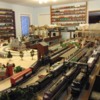I have a permanent layout now completed for about 8 years. I thoroughly fastened Gargraves trackage with screws to the cork roadbed overlying plywood and I have loosely ballasted the track. I have used K-line turnouts and Gargraves turnouts for the track switches. There is one main loop which splits into 2 tracks and then rejoins to the main loop again. Thus one Lionel train can be off while the other is running and vice versa. All three sections are wired into blocks with toggle switches. The trains have operated fine this way for the 8 years.
All of a sudden, the other day, the train shorted and will not operate on the main track loop, however, the 2 split side tracks operate fine each being insulated from each other and the main track with fiber pins. I have checked and traced the wires as well as ensured the fiber pins and connecting track are properly seated and positioned. I have checked the ZW transformer with a multimeter, it appears to be fine. I have even disconnected the permanent wires from the transformer and reconnected temporary wires between the transformer and just to the main loop. Now the train sluggishly runs on the loop and it shorts outs evidenced by the green light on the ZW dims and the trains stops dead on the tracks.
Although the attached photo was not taken to illustrate this electrical problem it will give an idea of what I am describing above. The 2nd and 3rd tracks from the right , that is with the ACL and NYC passenger trains are electrically insulated from each other and then connected and insulated from the main loop. Thus the three blocks and 3 toggle switches to operate them. Other tracks and trains are all completely separated from this and operate 100% separately.
Any ideas as to the problem is greatly appreciated.
Thanks, Stephen





